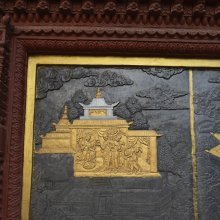Pawo: 2 definitions
Introduction:
Pawo means something in the history of ancient India. If you want to know the exact meaning, history, etymology or English translation of this term then check out the descriptions on this page. Add your comment or reference to a book if you want to contribute to this summary article.
Images (photo gallery)
India history and geography
Source: Mandala Texts: Ridam/Ladam: Closing Mountains to Human ActivityPawo (དཔའ་བོ་) refers to a type of Bhutanese Shaman or Oracle.—The ridam/ladam practice is deeply rooted in the Bhutanese spiritual worldview of seeing the surrounding environment as a living force. In the Pre-Buddhist belief system, natural surrounding including mountains, cliffs, forests, lakes and rivers were seen as formidable sites which embodied natural forces or are abodes of invisible forces of nature. Mountains are identified with mountain gods, forests as homes of territorial deities, cliffs as citadels of spirits, rivers as residences of water spirits, and so forth. These spirits came in many kinds such as nedag (གནས་བདག་) zhidag (གཞི་བདག་), pholha (ཕོ་ལྷ་), yullha (ཡུལ་ལྷ་), dud (བདུད་), tsen (བཙན་), gyalpo (རྒྱལ་པོ་), lu (ཀླུ་) etc. and they sometimes communicated with the people through shamans and oracles such as pawo (དཔའ་བོ་), pamo (དཔའ་མོ་), terdag (གཏེར་བདག་) and naljorm (རྣལ་འབྱོརམ་).
Source: Mandala Texts: Pacham: Dance of the HeroesPawo (དཔའ་བོ་) refers to certain spiritual beings in Bhutanese tradition.—Pacham dance (དཔའ་འཆམ་) represents more specifically the expressions of such enlightened energy as embodied in the graceful movements and acts of the spiritual beings known as pawo (དཔའ་བོ་) or heroes and pamo (དཔའ་མོ་) or heroines. In this context, the term pawo refers to the male deities and the pamo to the female divinities or spiritual beings who are said to mostly live in celestial realms of the Buddhas. One has to remember that these terms, in a different context, also refer to the class of male and female shamans in Bhutan.

The history of India traces the identification of countries, villages, towns and other regions of India, as well as mythology, zoology, royal dynasties, rulers, tribes, local festivities and traditions and regional languages. Ancient India enjoyed religious freedom and encourages the path of Dharma, a concept common to Buddhism, Hinduism, and Jainism.
See also (Relevant definitions)
Relevant text
Search found 2 books and stories containing Pawo; (plurals include: Pawos). You can also click to the full overview containing English textual excerpts. Below are direct links for the most relevant articles:
Tibet (Myth, Religion and History) (by Tsewang Gyalpo Arya)
4. Critique < [Chapter 4 - King Srongtsan Gampo and His Period]
3. Probability Analysis < [Chapter 4 - King Srongtsan Gampo and His Period]
5. Early Bon and Later Buddhist -Amalgamation < [Chapter 3 - Nyatri Tsanpo; The First King of Tibet]
Bodhisattvacharyavatara (by Andreas Kretschmar)
